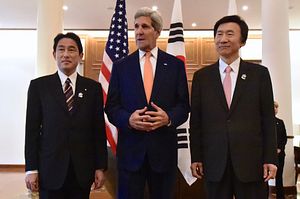Yesterday, my colleague Prashanth Parameswaran outlined the burgeoning trilateralism between India, Japan, and Australia. As Prashanth notes, the three countries have remarkable commonalities as democracies increasingly concerned by China’s assertive behavior in its near seas. The Japanese representative at the talks, Vice Foreign Minister Akitaka Saiki, noted that he and his Indian and Australia counterparts “had a full day discussion on China.” He added that the three partners agreed that “more or less … [they] are on the same page.”
The trilateral is one among many uniting like-minded states in the Asia-Pacific. Consider these additional trilateral dynamics in Asia, some of which have emerged in just last 18 months: the United States, Japan, and India meet trilaterally at a senior level; the United States, Japan, and Australia consult trilaterally and even share intelligence; the United States and its two East Asian allies, South Korea and Japan, have been ramping up their trilateral coordination as well (though this remains limited by poor ties between Seoul and Tokyo). Across these growing networks of trilateral cooperation and consultation, we see a convergence of like-minded states. These states share skepticism and concern about China’s rising influence as a security actor in Asia and largely seek ways to either preserve the status quo or prevent Beijing from altering it in ways deleterious to their interests.
So far, these various trilaterals have attracted little outside attention and understandably so: they’ve been short on deliverables and their outcomes have been anodyne, limited largely to increasing mutual understanding among high-level diplomats. Still, as tensions rise in the South China Sea over China’s intentions for Asia’s maritime commons and China embraces a new security posture, commensurate with its new military might, these trilateral networks could form the backbone of a broader security framework in Asia. Asia does not lack for regional organizations, but there is currently no real forum that allows for Asia’s prominent democracies with an appetite for preserving the regional status quo — Japan, India, South Korea, and Australia, certainly — to convene and consult.
This idea isn’t new. In fact, during his first stint as prime minister in 2006-2007, Shinzo Abe spearheaded a similar project. Back then, it was called a “Quadrilateral Initiative” and would have comprised Japan, the United States, India, and Australia. But China balked at that notion, and there simply wasn’t enough interest in Canberra, New Delhi, and indeed, Washington, to seriously entertain the idea. It didn’t help matters that Abe stuck around for hardly a year before stepping down, ushering in an era of one-year-only prime ministers until he returned in 2012. Since Abe’s return, we’ve heard scant mention of quadrilateralism, even as the situation in Asia has changed considerably.
To be entirely honest, in Japan’s case at least, bilateralism is paying dividends. Japan’s adjusted its security and defense posture since 2012, and has followed it up with dynamic diplomacy. In recent weeks, we’ve seen Japan emphasize its expanding security ties with Malaysia and the Philippines — two claimant states in the South China Sea. Last year, Japan and Vietnam — another claimant — drew closer on maritime security as well. For New Delhi and Canberra, while trilateralism is valuable for coordination purposes, bilateralism seems to do the job just as well.
It’s also worth recalling that China isn’t entirely excluded or isolated diplomatically. Though Beijing and Tokyo underwent a cold spell in their diplomatic interactions for almost 20 months, they’ve recent been engaging more, both bilaterally and trilaterally with South Korea. In fact, there are murmurings of a summit between the leaders of Japan, China, and South Korea. Down in New Delhi and Canberra, while concerns exist about China’s rise and behavior at sea, there is little interest in punishing China for breaching international norms.
This is where Washington comes into the equation. The United States will be an important player in determining whether we’ll see these like-minded states embrace trilateralism and quadrilateralism. Washington’s starting to take the gloves off with regard to Beijing, and while it remains concerned about avoiding the optics of “containment,” it can hardly afford to pass up the advantages of bringing Asian democracies together in upholding the regional status quo on issues like the freedom of navigation and maritime security.
As Prashanth noted, trilaterals are proliferating in the Asia-Pacific among like-minded states and they’ll certainly play a role in determining the future of Asia’s security architecture. What’s unclear is to what extent they’ll lead to a broader network of partnered states, effectively coming together to oppose changes to the status quo, and if they’ll be sustainable given the shifting sands of democratic politics and economics across the region. Whatever the uncertainties, policymakers in Washington, Tokyo, New Delhi, Canberra and elsewhere shouldn’t rule out the utility of trilateral and quadrilateral consultations.

































